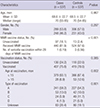1. Kuter BJ, Weibel RE, Guess HA, Matthews H, Morton DH, Neff BJ, Provost PJ, Watson BA, Starr SE, Plotkin SA. Oka/Merck varicella vaccine in healthy children: final report of a 2-year efficacy study and 7-year follow-up studies. Vaccine. 1991; 9:643–647.
2. Reuss AM, Feig M, Kappelmayer L, Siedler A, Eckmanns T, Poggensee G. Varicella vaccination coverage of children under two years of age in Germany. BMC Public Health. 2010; 10:502.
3. Fu C, Wang M, Liang J, Xu J, Wang C, Bialek S. The effectiveness of varicella vaccine in China. Pediatr Infect Dis J. 2010; 29:690–693.
4. Tan HF, Chang CK, Tseng HF, Lin W. Evaluation of the national notifiable disease surveillance system in Taiwan: an example of varicella reporting. Vaccine. 2007; 25:2630–2633.
5. Park B, Lee YK, Cho LY, Go UY, Yang JJ, Ma SH, Choi BY, Lee MS, Lee JS, Choi EH, et al. Estimation of nationwide vaccination coverage and comparison of interview and telephone survey methodology for estimating vaccination status. J Korean Med Sci. 2011; 26:711–719.
6. Marin M, Marti M, Kambhampati A, Jeram SM, Seward JF. Global varicella vaccine effectiveness: a meta-analysis. Pediatrics. 2016; 137:e20153741.
7. Bialek SR, Perella D, Zhang J, Mascola L, Viner K, Jackson C, Lopez AS, Watson B, Civen R. Impact of a routine two-dose varicella vaccination program on varicella epidemiology. Pediatrics. 2013; 132:e1134–40.
9. Cornfield J. A method of estimating comparative rates from clinical data; applications to cancer of the lung, breast, and cervix. J Natl Cancer Inst. 1951; 11:1269–1275.
10. Niccolai LM, Ogden LG, Muehlenbein CE, Dziura JD, Vázquez M, Shapiro ED. Methodological issues in design and analysis of a matched case-control study of a vaccine’s effectiveness. J Clin Epidemiol. 2007; 60:1127–1131.
11. Oh SH, Choi EH, Shin SH, Kim YK, Chang JK, Choi KM, Hur JK, Kim KH, Kim JY, Chung EH, et al. Varicella and varicella vaccination in South Korea. Clin Vaccine Immunol. 2014; 21:762–768.
12. Liese JG, Cohen C, Rack A, Pirzer K, Eber S, Blum M, Greenberg M, Streng A. The effectiveness of varicella vaccination in children in Germany: a case-control study. Pediatr Infect Dis J. 2013; 32:998–1004.
13. Vázquez M, LaRussa PS, Gershon AA, Niccolai LM, Muehlenbein CE, Steinberg SP, Shapiro ED. Effectiveness over time of varicella vaccine. JAMA. 2004; 291:851–855.
14. Marin M, Zhang JX, Seward JF. Near elimination of varicella deaths in the US after implementation of the vaccination program. Pediatrics. 2011; 128:214–220.
15. Guris D, Jumaan AO, Mascola L, Watson BM, Zhang JX, Chaves SS, Gargiullo P, Perella D, Civen R, Seward JF. Changing varicella epidemiology in active surveillance sites--United States, 1995-2005. J Infect Dis. 2008; 197:Suppl 2. S71–5.
16. Sheffer R, Segal D, Rahamani S, Dalal I, Linhart Y, Stein M, Shohat T, Somekh E. Effectiveness of the Oka/GSK attenuated varicella vaccine for the prevention of chickenpox in clinical practice in Israel. Pediatr Infect Dis J. 2005; 24:434–437.
17. Vázquez M, LaRussa PS, Gershon AA, Steinberg SP, Freudigman K, Shapiro ED. The effectiveness of the varicella vaccine in clinical practice. N Engl J Med. 2001; 344:955–960.
18. Hwang KK, Park SY, Kim SJ, Ryu YW, Kim KH. Restriction fragment length polymorphism analysis of varicella-zoster virus isolated in Korea. J Korean Soc Virol. 1991; 21:201–210.
19. Hwang KK, Chun BH, Park HS, Park SY, Kim KH, Moon HM. Marker test for attenuation of varicella-zoster viruses isolated in Korea. J Korean Soc Virol. 1992; 22:105–109.
20. Sohn YM, Park CY, Hwang KK, Woo GJ, Park SY. Safety and immunogenicity of live attenuated varicella virus vaccine (MAV/06 strain). J Korean Pediatr Soc. 1994; 37:1405–1413.
21. Sohn YM, Yu GJ, Kim PK, Kim KY, Park CY, Kim MR, Jeung WK, Hwang KK, Woo GJ, Park SY. Immunogenicity and safety of live attenuated vaccine(MAV/06srtain) on healthy children and immunocompromised children. J Korean Pediatr Soc. 1995; 38:771–777.
22. Kim DJ, Park HS, Lee SY, Park KS, Kim TK, Song YH, Choi J, Han JW, Song YS, Park TJ, et al. Epidemiology of varicella in Korea based on pediatrician’s office practice. J Korean Pediatr Soc. 1997; 40:620–628.
23. Kim MR, Park JS, Kim DH, Lee HR, Park CY. A clinical and epidemiologic study on varicella in children. Korean J Pediatr Infect Dis. 1998; 5:88–95.
24. Choi UY, Huh DH, Kim JH, Kang JH. Seropositivity of varicella zoster virus in vaccinated Korean children and MAV vaccine group. Hum Vaccin Immunother. Forthcoming. 2016.








 PDF
PDF ePub
ePub Citation
Citation Print
Print





 XML Download
XML Download